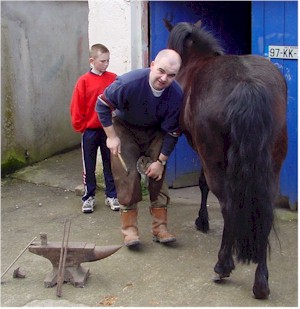
BLACK-SMITH
FARRIER

Patrick Comerford - 2001 continuing a proud tradition
Before the industrial revolution no rural community could exist without a smith. The blacksmith shoed horses and manufactured and repaired many of the necessities of farming and domestic life.For many centuries the smith was the hub of
village life. There, in the glow of the forge, their faces lit red by showers of
bright sparks in murky gloom, people waiting for work to be done met those who
were, simply waiting; Gossip and parish news were exchanged to the measured beat
of the hammer on anvil and the hissing of steam. It was especially popular in
winter when the fires were roaring.
In medieval times there was at least
one smith in every village, it
would
often be sited in the centre of the village, usually, strategically, at
crossroads. The smith was in effect a miniature factory, turning out all manner of
domestic utensils, agricultural equipment and craftmens tools, from ploughs to
cooking pots, billhooks and boot scrapers.
Men
of iron
Blacksmiths were among the earliest
independent craftsmen, their own master, they contracted to do jobs rather than
work hours-though the hours they did work were long and arduous. A blacksmith
had to acquire a formidable array of skills and be physically immensely
strong-like Long fellows mighty man….with large and sinewy hands and the
muscles of his browny arms are as strong as iron bands. He might have other jobs
to do as well as smithing. The job of village barber often fell to the smith and
many were not above a spot of dentistry. He was sought out as an advisor or
oracle and he could conduct a form of marriage over his anvil. Partly this was a
testament to his status in the community, and partly it was in reference to his
seemingly magical mastery of the fire and iron. The process of extracting iron
from the ground and shaping it into tools and weapons is about 4000 years old.
All
the metals previously worked by man were soft enough to be worked cold: -copper,
tin, silver and gold. The shaping of iron however required great heat
and once cooled it was harder than any other metal.
The first blacksmith (so called because
iron was known as blackmetal) were itinerant going from manor to manor and often
smelting their own iron. Their favourite material was always wrought iron
- 99.9%
pure iron, resistant to corrosion and easily shaped when hot. (This has largely
been superseded by mild steel.) With the introduction of the blast furnace in the
fifteenth century the production of iron was stepped up and taken out of the
hands of the smiths and monasteries to become an industry in its own right. The
smith set up his own workshop, bought his iron from the iron master and
concentrated on what his skill could make of it.
The
blacksmith rarely worked alone. Most supported one or two labourers, apprentices
and a mate who apart from undertaking the simpler jobs at the smith’s
direction
worked the bellows, welded the hammers and helped to look after the horses.
Home
repairs
The development of gas welding meant that
farmers could repair their own tools and equipment thus removing a major source
of employment for the traditional blacksmith.